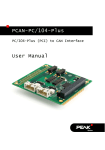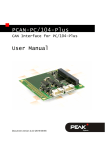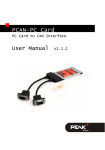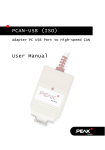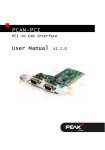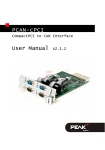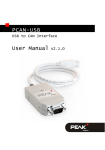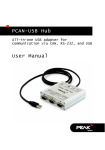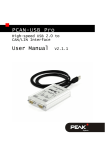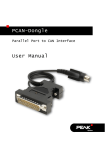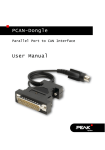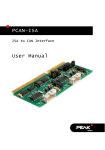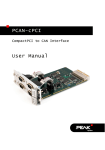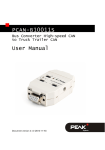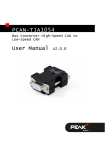Download PCAN-PC Card - User Manual
Transcript
PCAN-PC Card PC Card to CAN Interface User Manual PCAN-PC Card – User Manual Products taken into account Product Name Model Item Number PCAN-PC Card Single Channel One CAN channel IPEH-002090 PCAN-PC Card Dual Channel Two CAN channels IPEH-002091 PCAN-PC Card Single Channel opto-decoupled One CAN channel, galvanic isolation for CAN connection IPEH-002092 PCAN-PC Card Dual Channel opto-decoupled Two CAN channels, galvanic isolation for CAN connections IPEH-002093 The cover picture shows the product PCAN-PC Card Dual Channel. The Single Channel versions have an identical form factor but only one breakout cable for the CAN connection. Product names mentioned in this manual may be the trademarks or registered trademarks of their respective companies. They are not explicitly marked by “™” and “®”. © 2009 PEAK-System Technik GmbH PEAK-System Technik GmbH Otto-Roehm-Strasse 69 64293 Darmstadt Germany Phone: +49 (0)6151 8173-20 Fax: +49 (0)6151 8173-29 www.peak-system.com [email protected] Issued 2009-03-19 2 PCAN-PC Card – User Manual Contents 1 1.1 1.2 1.3 2 2.1 2.2 2.3 3 3.1 3.2 4 4.1 4.2 5 Introduction 4 Properties at a Glance System Requirements Scope of Supply Installation 4 5 5 6 Installing the Software and the PCAN-PC Card Connecting the CAN Bus Supplying External Devices via the CAN Connector Operation 6 7 8 10 Status LED Removing the Card Safely Software 10 10 12 PCAN-View for Windows Linking Own Programs with PCAN-Light Technical Specifications 12 14 15 Appendix A CE Certificate 17 Appendix B Quick Reference 18 3 PCAN-PC Card – User Manual 1 Introduction The PCAN-PC Card provides one or two CAN channels in computers with PC Card slot. Software interfaces exist for different operating systems, so programs can easily access a connected CAN bus. Tip: At the end of this manual (Appendix B) you can find a Quick Reference with brief information about the installation and operation of the PCAN-PC Card. 1.1 Properties at a Glance Card for PC Card slot, PCMCIA type II 1 or 2 High-speed CAN channels (ISO 11898-2) CAN specifications 2.0A and 2.0B applicable CAN transfer rates up to 1 Mbit/s CAN connection 9-pin D-Sub male, pin assignment according to CiA recommendation 102 DS Galvanic isolation up to 100 V for the CAN interface (only optodecoupled versions IPEH-002092 and IPEH-002093), separate for each CAN connection Software-switchable 5-Volt power supply at the CAN connector for external devices with low power consumption (e.g. bus converters) Device drivers and programming interfaces for operating systems Windows (starting with 2000) and Linux 4 PCAN-PC Card – User Manual Note: This manual describes the use of the PCAN-PC Card with Windows. You can find device drivers for Linux and the corresponding application information on PEAK-System's website under www.peak-system.com/linux. 1.2 System Requirements The following prerequisites must be given, so that the PCANPC Card can be used properly: A vacant PC Card slot at the computer, PCMCIA type II Operating system Windows (Vista 32-bit, XP SP2, 2000 SP4) or Linux (incl. 64-bit versions) 1.3 Scope of Supply The scope of supply normally consists of the following parts: PCAN-PC Card with one or two CAN connectors (fixed cables with D-Sub plugs) CD with software (drivers, utilities), programming examples, and documentation 5 PCAN-PC Card – User Manual 2 Installation This chapter deals with the software setup for the PCAN-PC Card under Windows, the installation of the card in the computer, and the connection of a CAN bus. 2.1 Installing the Software and the PCANPC Card We recommend that you setup the driver before connecting the PCAN-PC Card to the computer for the first time. Do the following to install the driver: 1. Make sure that you are logged in as user with administrator privileges (not needed for normal use of the PCAN-PC Card later on). 2. Insert the supplied CD into the appropriate drive of the computer. Usually a navigation program appears a few moments later. If not, start the file Intro.exe from the root directory of the CD. 3. On the page English > Drivers activate the entry PCANPC Card. 4. Click on Install now. The setup program for the driver is executed. 5. Follow the instructions of the program. Tip: If you don't want to install the CAN monitor PCAN-View for Windows onto hard disk together with the driver, you have the option to start the program later directly from CD without prior installation. 6 PCAN-PC Card – User Manual Do the following to connect the PCAN-PC Card to the computer and complete the initialization: 1. Insert the PCAN-PC Card into a PC Card slot of your computer. The computer can remain powered on. 2. Windows reports that new hardware has been detected and possibly starts an installation wizard. This depends on the used Windows version. If applicable, confirm the steps for driver initialization. 3. Afterwards you can work as user with restricted rights again, if applicable. After the installation process is finished successfully an LED is on for each CAN channel of the PCAN-PC Card. 2.2 Connecting the CAN Bus The arrangement of the CAN channels at the PCAN-PC Card is as follows: CAN 1 CAN 2 Figure 1: Arrangement of the CAN channels (CAN 2 only with Dual Channel versions) 7 PCAN-PC Card – User Manual A High-speed CAN bus (ISO 11898-2) is connected to the 9-pin D-Sub connector. The pin assignment corresponds to the CiA recommendation 102 DS. Figure 2: Pin assignment High-speed CAN (view onto a male D-Sub connector at the PCAN-PC Card) With pin 1 devices with low power consumption (e.g. bus converters) can be directly supplied via the CAN connector. At delivery this pin is deactivated. You can find a detailed description in the following section 2.3. Tip: You can connect a can bus with a different transmission standard via a bus converter. PEAK-System offers different bus converter modules (e.g. PCAN-TJA1054 for a Low-speed CAN bus according to ISO 11898-3). 2.3 Supplying External Devices via the CAN Connector Optionally a 5-Volt supply can be switched onto pin 1 of a D-Sub CAN connector (with the Dual Channel version simultaneously for both CAN connectors). Thus devices with low power consumption (e.g. bus converters) can be directly supplied via the CAN connector. 8 PCAN-PC Card – User Manual Note: The software for switching the 5-Volt supply is not part of delivery. On this matter please contact PEAK-System (contact data on page 2). When using this option the 5-Volt supply is directly connected to the power supply of the PCAN-PC Card (coming from the computer) and is not fused separately. The opto-decoupled versions of the card contain an interconnected DC/DC converter. Therefore the current output is limited to about 50 mA. Attention! Risk of short circuit! If the option described in this section is activated, you may only connect or disconnect CAN cables or peripheral systems (e.g. bus converters) to or from the PCAN-PC Card while it is de-energized (the card is not connected to the computer). Consider that some computers still supply the PC Card slot with power even when they are turned off (standby operation). 9 PCAN-PC Card – User Manual 3 Operation 3.1 Status LED The PCAN-PC Card has a status LED for each existing CAN channel which may be in one of the following conditions: Off: A connection to a driver of the operating system is not established. On: The card is initialized. There's a connection to a driver of the operating system. Slowly flashing: A software application is connected to the card. Quickly flashing: Data is transmitted via the connected CAN bus. 3.2 Removing the Card Safely If you want to unplug the PCAN-PC Card from the computer during a Windows session, pay attention to the following notes: When the PCAN-PC Card is connected and the driver is active, you can find the icon for safely removing hardware in the notification area of the Taskbar (on the lower right of the desktop). Figure 3: Icon for removing hardware safely 10 PCAN-PC Card – User Manual After clicking on the icon select the command Remove PCANPC Card Device. When the LED on the PCAN-PC Card is off (at the Dual Channel versions both LEDs), you can remove the card from the computer's PC Card slot. 11 PCAN-PC Card – User Manual 4 Software This chapter deals with the provided software and the software interface to the PCAN-PC Card. 4.1 PCAN-View for Windows PCAN-View for Windows is a simple CAN monitor for viewing and transmitting CAN messages. Figure 4: The main window of PCAN-View for Windows Starting PCAN-View You can start PCAN-View in two ways: If PCAN-View is already installed on the hard disk, open the Windows Start menu, go to Programs > PCAN-Hardware, and select the entry PCAN-View PC Card. 12 PCAN-PC Card – User Manual In order to start directly from the supplied CD without prior installation use the navigation program (Intro.exe), go to English > Tools, and in the entry PCAN-View for PC Card click on Start. A dialog box for the selection of the CAN hardware as well as the setting of the CAN parameters appears after the program start. Figure 5: Selection of the CAN specific hardware and parameters From the list “Available CAN hardware” select the CAN channel to be used. Note that the count of the CAN controllers starts at 0, i.e. the CAN controller 0 is assigned to CAN channel 1. As a rule you can leave the remaining preset values and confirm the dialog box with OK. You can find further information about the use of PCAN-View in the help which you can invoke in the program via the menu Help or the F1 key. 13 PCAN-PC Card – User Manual 4.2 Linking Own Programs with PCAN-Light On the provided CD you can find files for software development in the directory branch /Develop/Windows. They exclusively serve the linking of own programs to hardware by PEAK-System with the help of the installed device driver under Windows. Further more the CD-ROM contains header files and examples for creating own applications in conjunction with the PCAN-Light drivers. Please read the detailed documentation of the interface (API) in each header file. You can find further information in the text and help files (file name extensions .txt and .chm). Notes about the License Device drivers, the interface DLL, and further files needed for linking are property of the PEAK-System Technik GmbH and may be used only in connection with a hardware component purchased from PEAK-System or one of its partners. If a CAN hardware component of third party suppliers should be compatible to one of PEAKSystem, then you are not allowed to use or to pass on the driver software of PEAK-System. PEAK-System assumes no liability and no support for the PCANLight driver software and the necessary interface files. If third party suppliers develop software based on the PCAN-Light driver and problems occur during use of this software, please, consult the software provider. To obtain development support, you need to own a PCAN-Developer or PCAN-Evaluation version. 14 PCAN-PC Card – User Manual 5 Technical Specifications Connectors Computer PC Card PCMCIA type II (16-bit, 5 V) CAN D-Sub (m), 9 pins (at Dual Channel version 2 x) Pin assignment according to CiA recommendation 102 DS Opto-decoupled versions: galvanic isolation up to 100 V (separate for each CAN channel) CAN Specification ISO 11898-2 High-speed CAN (up to 1 Mbit/s) 2.0A (standard format) and 2.0B (extended format) Controller NXP (Philips) SJA1000T Transceiver NXP (Philips) PCA82C251 Supply Supply voltage +5 V DC (via PC Card slot) Current consumption IPEH-002090 (Single Channel): IPEH-002091 (Dual Channel): IPEH-002092 (Single Ch. opto-dec.): IPEH-002093 (Dual Ch. opto-dec.): max. 150 mA max. 250 mA max. 250 mA max. 400 mA Measures Size (without cables) 116 x 54 x 12 mm (4 9/16 x 2 1/8 x 1/2 inches) (L x W x D) Weight IPEH-002090 (Single Channel): IPEH-002091 (Dual Channel): IPEH-002092 (Single Ch. opto-dec.): IPEH-002093 (Dual Ch. opto-dec.): Continued on the next page 15 55 g (1.9 oz.) 75 g (2.7 oz.) 55 g (1.9 oz.) 76 g (2.7 oz.) PCAN-PC Card – User Manual Environment Operating temperature 0 - +85 °C (+32 - +185 °F) Storage temperature -40 - +100 °C (-40 - +212 °F) Relative humidity 15 - 90 %, not condensing EMC EN 55024:2003-10 EN 55022:2007-04 EC directive 2004/108/EG 16 PCAN-PC Card – User Manual Appendix A CE Certificate 17 PCAN-PC Card – User Manual Appendix B Quick Reference Software/Hardware Installation under Windows Before connecting the PCAN-PC Card to the computer set up the corresponding software package from the supplied CD (with administrator privileges). Afterwards insert the card into a PC Card slot of the computer. The card is recognized by Windows and the driver is initialized. After the installation process is finished successfully a LED is on for each CAN channel of the card. Getting Started under Windows Run the CAN monitor PCAN-View from the Windows Start menu as a sample application for accessing the PCAN-PC Card. You can use the preset parameters for initialization of the card without changes (select the desired CAN channel, when using the Dual Channel version). High-speed CAN connector (D-Sub, 9 pins) 18


















